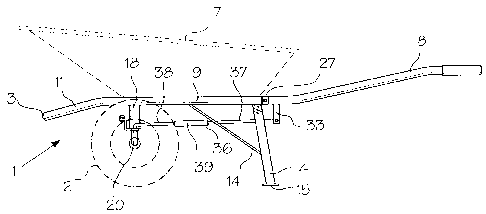Some of the information on this Web page has been provided by external sources. The Government of Canada is not responsible for the accuracy, reliability or currency of the information supplied by external sources. Users wishing to rely upon this information should consult directly with the source of the information. Content provided by external sources is not subject to official languages, privacy and accessibility requirements.
Any discrepancies in the text and image of the Claims and Abstract are due to differing posting times. Text of the Claims and Abstract are posted:
| (12) Patent Application: | (11) CA 2518838 |
|---|---|
| (54) English Title: | STEERING MECHANISM FOR WHEELBARROW |
| (54) French Title: | MECANISME DE DIRECTION POUR BROUETTE |
| Status: | Deemed Abandoned and Beyond the Period of Reinstatement - Pending Response to Notice of Disregarded Communication |
| (51) International Patent Classification (IPC): |
|
|---|---|
| (72) Inventors : |
|
| (73) Owners : |
|
| (71) Applicants : |
|
| (74) Agent: | |
| (74) Associate agent: | |
| (45) Issued: | |
| (22) Filed Date: | 2005-09-12 |
| (41) Open to Public Inspection: | 2007-03-12 |
| Examination requested: | 2010-08-30 |
| Availability of licence: | N/A |
| Dedicated to the Public: | N/A |
| (25) Language of filing: | English |
| Patent Cooperation Treaty (PCT): | No |
|---|
| (30) Application Priority Data: | None |
|---|
A steerable wheelbarrow includes a pair of handles rotatably connected to the
rear end of the frame of the wheelbarrow for rotation around a horizontal
axis, and a
pair of linkages connecting the handles to L-shaped, wheel carrying axles,
which are
interconnected by a separate linkage, whereby rotation of the handles in
opposite
directions around the horizontal axis results in rotation of the axles around
parallel,
vertical axes to turn the wheelbarrow. A stop mechanism limits turning of the
wheels to
decrease the likelihood of tipping during turning.
Note: Claims are shown in the official language in which they were submitted.
Note: Descriptions are shown in the official language in which they were submitted.

2024-08-01:As part of the Next Generation Patents (NGP) transition, the Canadian Patents Database (CPD) now contains a more detailed Event History, which replicates the Event Log of our new back-office solution.
Please note that "Inactive:" events refers to events no longer in use in our new back-office solution.
For a clearer understanding of the status of the application/patent presented on this page, the site Disclaimer , as well as the definitions for Patent , Event History , Maintenance Fee and Payment History should be consulted.
| Description | Date |
|---|---|
| Revocation of Agent Requirements Determined Compliant | 2020-09-01 |
| Application Not Reinstated by Deadline | 2012-09-12 |
| Time Limit for Reversal Expired | 2012-09-12 |
| Deemed Abandoned - Failure to Respond to Maintenance Fee Notice | 2011-09-12 |
| Amendment Received - Voluntary Amendment | 2010-09-28 |
| Letter Sent | 2010-09-08 |
| All Requirements for Examination Determined Compliant | 2010-08-30 |
| Request for Examination Requirements Determined Compliant | 2010-08-30 |
| Request for Examination Received | 2010-08-30 |
| Application Published (Open to Public Inspection) | 2007-03-12 |
| Inactive: Cover page published | 2007-03-11 |
| Inactive: First IPC assigned | 2006-04-07 |
| Inactive: IPC assigned | 2006-04-07 |
| Inactive: IPC assigned | 2006-04-07 |
| Letter Sent | 2005-11-24 |
| Inactive: Single transfer | 2005-10-27 |
| Inactive: Courtesy letter - Evidence | 2005-10-25 |
| Application Received - Regular National | 2005-10-21 |
| Inactive: Filing certificate - No RFE (English) | 2005-10-21 |
| Small Entity Declaration Determined Compliant | 2005-09-12 |
| Abandonment Date | Reason | Reinstatement Date |
|---|---|---|
| 2011-09-12 |
The last payment was received on 2010-08-30
Note : If the full payment has not been received on or before the date indicated, a further fee may be required which may be one of the following
Patent fees are adjusted on the 1st of January every year. The amounts above are the current amounts if received by December 31 of the current year.
Please refer to the CIPO
Patent Fees
web page to see all current fee amounts.
| Fee Type | Anniversary Year | Due Date | Paid Date |
|---|---|---|---|
| Application fee - small | 2005-09-12 | ||
| Registration of a document | 2005-10-27 | ||
| MF (application, 2nd anniv.) - small | 02 | 2007-09-12 | 2007-08-17 |
| MF (application, 3rd anniv.) - small | 03 | 2008-09-12 | 2008-09-04 |
| MF (application, 4th anniv.) - small | 04 | 2009-09-14 | 2009-09-09 |
| Request for examination - small | 2010-08-30 | ||
| MF (application, 5th anniv.) - small | 05 | 2010-09-13 | 2010-08-30 |
Note: Records showing the ownership history in alphabetical order.
| Current Owners on Record |
|---|
| LES ACIERS ROBOND INC. |
| Past Owners on Record |
|---|
| MICHEL BEAUDOIN |